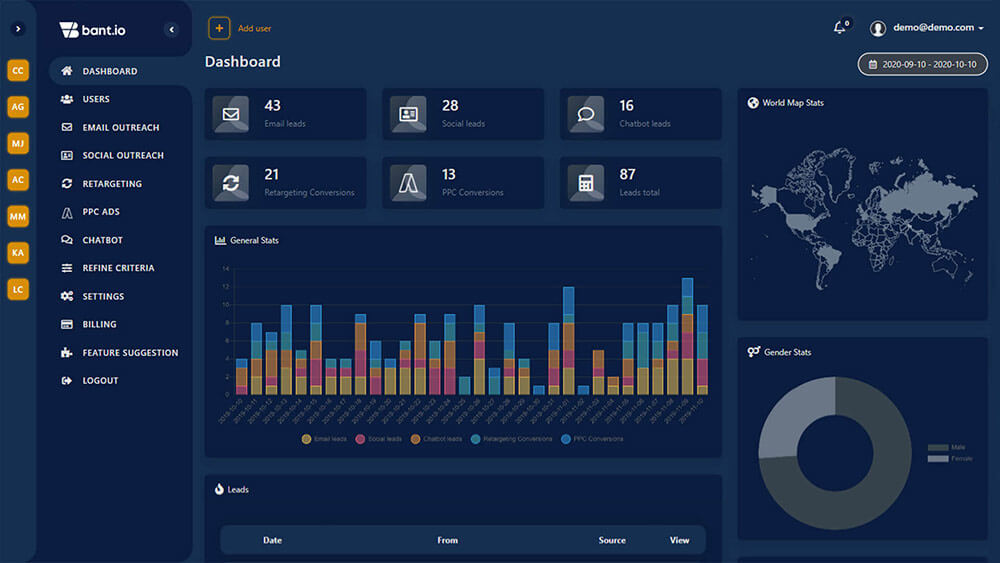Any large B2B company will have a buying center responsible for making any purchase decision. Marketing teams need to be able to identify members of a target business’s buying center in order to tailor their marketing efforts and improve their outreach.
Without understanding who is in the buying center and what influence they have over the purchasing decision of a company, you’ll waste time and effort reaching out to the wrong people and pitching to members of the company who have no authority to make a purchase.
In this post, we’ll cover what a B2B buying center is, how you can quickly identify it within a company you are aiming to do business with, and how to reach out effectively to get a positive response.
If you want to automate the entire process of reaching out to buying centers to improve your ROI and bring in more warm leads, we can help. Request a demo with Bant.io and we’ll show you how we’ll use our experiment-driven software to secure you new leads every single month.
What is a Buying Center in B2B?
The buying center isn’t a new concept. In fact, it’s attributed to Webster and Wind over 40 years ago. But even still, it’s an important concept to B2B sales reps when trying to secure new leads.
The buying center is the group of people within a business responsible for making the purchase decision. This isn’t necessarily the same group of people for every transaction, and the number of people involved varies between businesses and industries.
For example, if you’re selling IT software, you’ll likely find an IT executive is part of the buying center along with the CEO, marketing leader, and perhaps a member of the sales team.
However, if you’re B2B selling recruitment software, it’s more likely the buying circle will include the head of recruitment.
Research shows that 81% of employees who have no decision power (also known as non-c-suiters) are still involved in the first stages of the buying decision process. Whether that’s research, information gathering, booking phone calls, etc.
Therefore it’s important to know who is within the buying center of any company you want to do business with as well as the individuals surrounding the center who you will likely be marketing to.
The Role of the Buying Center in B2B

The larger the company, the more people within the buying center. This is because purchasing decisions have massive consequences within the B2B sector. Whether it’s reducing costs, improving operations, or planning for the future – every purchase decision must have a tangible impact on the business to be worth the investment.
With so much riding on each purchasing decision, the role of the buying center is to give multiple points of view on each purchase process. With several people in charge of each decision, it’s less likely mistakes will be made and ineffective systems implemented.
What’s more, most purchasing decisions affect multiple departments within a business. Having different team members from each department involved in the decision ensures that the decision benefits each department.
Roles in The Buying Center
Although the buyer center changes and can include different people depending on the type of purchase being considered, there are certain roles within the center that are always present during the B2B buying process.
The user
This person works directly with the product or service every day within the business. They don’t usually have purchase power, but they are involved in the decision-making process since they will be the ones using the new product.
The data collector
This person researches the different options available during the buying process. They also don’t usually have purchase power, but they are a key member of the buying center to market to since they will be the ones gathering information on the best companies to do business with during the awareness stage of the buyer journey.
Data collectors vary widely from assistants right through to managing directors, so it’s important to know who in a company carries out this role.
The buyer
This person is responsible for the practical aspects of the purchase and holds decision power. They will be involved in finding suppliers, negotiating pricing, handling discounts, and ironing out the terms of contracts.
This is another important person for your sales team to know. The best way to communicate value to this person is using risk-lowering strategies such as guarantees, free trial periods, inclusive deals, and high levels of transparency.
The consultant
This person supports the buyer center with extensive knowledge and experience of similar products or services. They will often be brought in to work alongside sales reps or marketing agents to get a full overview of the current state of the business so they can give expert advice on whether a product or service is the right solution.
Although they don’t hold purchasing power since they are not part of the company, they do have significant sway over the other members of the center.
The decision-maker
This is usually a high-level member of senior management who is responsible for ensuring the best interest of the business’s bottom line. They will review the information gathered by other members of the buying center and have the overall decision on whether to move forward with a purchase.
This person is usually most interested in facts and figures. When marketing, the best way to reach this person is with short, concise messages that show the tangible gains the company could get with your product or service.
Who Influences the B2B Buying Decisions of the Buying Center?

Although those within the buying center (and the decision-maker specifically) do get the final say over purchase decisions, their buying behavior is influenced by a sphere of individuals around them.
This includes people referred to as gatekeepers (assistants and members of staff you need to talk to before reaching the decision-makers), sales reps, financial advisors, investors, and more.
Those who have the most sway will depend on the product, which is why it’s crucial to understand who within a company you’re marketing to and who will be using your product.
Prior knowledge and established relationships
Relationships or prior knowledge within the buyer center are extremely influential when making purchase decisions. In-person relationships are often established during meetings and conferences.
However, knowledge of potential brands online can also influence decisions. With the availability of quality information online, companies don’t need to have prior experience with a brand to consider them for a new product or service.
In fact, research shows that B2B buyers spend just 17% of their time meeting potential vendors when considering a purchase – this time drops to around 5% per sales rep when they are considering multiple businesses.
How to Reach the B2B Buying Center
A typical buying group in a B2B company can have between six and ten decision-makers. To start, it’s important to identify each person with the buying center so you know exactly who you are trying to reach and the best way to contact them.
Here are some tips for reaching out to the members of a B2B buying group with better customer service to improve your chances of getting a meeting.
Don’t overcomplicate your introduction
It’s likely you’ll first have to contact a gatekeeper when reaching a buying center. This is often an assistant or member of staff that prevents direct contact with a decision-maker to protect their time.
If this is the case, keep your introduction short and to the point. You don’t need to provide your pitch to a person in a gatekeeping role, but you do need to communicate your value enough to secure a meeting.
Research your targets
Members of buying centers receive dozens of cold emails every day for new products and services. Most have switched off to spam and ignore 90% of the messages they receive.
To cut through the noise and stand out as a valuable option, you need to do your research and find out more about your target buyer.
Some quick research on your prospect’s LinkedIn will show you their recent articles, projects, awards, or other information you can use to alter your pitch and show you put thought into who you are contacting.
Automate your outreach
With automation tools like Bant.io, you can automate your outreach efforts to buyer centers. We have a team that will implement your outreach strategy, analyze your performance, and provide recommendations based on results to make sure your cold outreach is as effective as possible.

With automated outreach, it’s much easier to create personalized campaigns and track your progress so you know exactly how often you’ve followed up and how well your campaigns are working.
Focus on a problem you can solve
Within your outreach, focus on highlighting a single problem your B2B customers may be facing and then offer your product or service as an easy, succinct solution.
Many marketers make the mistake of trying to provide too much ‘value’ within a single outreach message, but those within a buyer center are looking for specific solutions to singular problems.
Grab attention by highlighting a pain point and solving it with your product or service. Make sure to highlight the benefit they will experience from implementing your solution to drive home the value they’ll get investing with you.
Contacting Your Prospects at The Right Time
Understanding and researching the buying center in a prospect’s business is an important step toward improving your outreach. Once you know who holds purchasing power, you can tailor your marketing towards them specifically.
However, not all potential customers are ready to buy. You might have the best service in the world, but if the buyer center isn’t in the buying phase of making that final purchasing decision, you might waste valuable time and resources marketing to the wrong company.
That’s where the buyer journey comes in. Mapping out the buyer journey for your product or service will help you pinpoint the best times to begin your outreach and contact your prospective buyers exactly when they need you.
Make sure to head to our buyer journey guide to find out how to map your own buyer journey and tailor your marketing accordingly.

